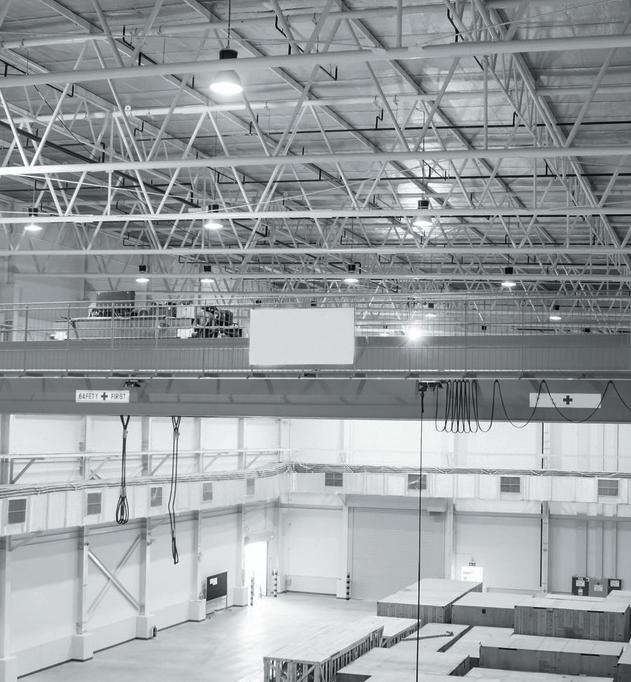
4 minute read
Minister Husic’s Column
Minister for Industry and Science
Ed Husic
Advertisement
REDUCE MAINTENANCE COSTS ON OVERHEAD CRANES

LOAD LIMITERS
ROPE AND CHAIN CRANES AND HOISTS
• Helps reduce the risk of accidents • Protects against overloading of Crane and supporting structures • Quick and easy installation and available for all capacity cranes • Available preset or easily calibrated on site • Helps reduce maintenance costs • Minimizes down time • Automatic reset by reducing the load
CONDUCTOR BAR
• Available in steel & copper • Quickly and easily installed • Supports required only every 1.5m • Also available in a compact cluster range SIDE PULL PREVENTERS / ROPE GUIDE PROTECTOR
Prevents side pulling and protects rope guides and drums on most multi-fall cranes & hoist • Prevent dragging of loads • Easily fitted to any crane/hoist • Helps reduce down time
Liftco Industrial Supplies Pty Ltd (02) 9829 4411
As Industry and Science Minister, I often speak about the importance of science and technology for developing our industries.
Central to that is an adequate supply of workers with education and skills in science, technology, engineering and mathematics (STEM).
During September’s Jobs and Skills Summit, participants highlighted the need to promote the importance of STEM education and careers in meeting our current and future workforce needs.
One clear way of increasing the number of workers with STEM skills is by widening the pipeline of talent.
We need to create more pathways for women, First Nations people, migrants, mature workers and those living with disability.
The 2022 edition of the Australian Government’s STEM Equity Monitor issued in late September shows that while there has been progress in increasing the participation of women, there is still a lot of work to be done.
The data showed that the number of women enrolling in university STEM courses increased by 24% between 2015 and 2020. However, as a proportion of all people working in STEM-qualified jobs, women’s participation grew by just 2% to 15% in 2021.
Moreover, only 23% of senior management and 8% of CEOs in STEMqualified industries are women and, on average, women still earn 18% less than men across all STEM industries.
Frankly, that’s not good enough.
More effort has to be made to increase diversity in STEM and technology sectors, not only because it is the right thing to do, but because it is needed to meet the growing demand for skilled workers.
Research shows that diverse businesses are strong and successful businesses.
The Government is committed to making that effort and succeeding. And we want to work closely with industry to make sure real change is achieved.
Following the Jobs and Skills Summit, we announced a review to determine how existing government programs to support women and girls in STEM can be reformed to support greater diversity in Australia’s science and technology sectors.
We are also determined to remove cultural and structural barriers that
limit participation and retention of women and other under-represented groups in STEM. To further develop skills, the government is also supporting a Digital and Tech Skills Compact between government, unions and technology employers. Working with industry, unions and training organisations, the government will develop a pilot scheme offering a blend of employment and training to support workers entering the tech industry. This could form the basis of digital traineeships or ‘digital tradies’ entering businesses across the economy. The Digital and Tech Skills Compact is an important step towards achieving our target of 1.2 million long-term, tech-related jobs by 2030. In the past month I have also cleared the way to “The Digital introducing new National Science and Tech Skills and Research Priorities. These Compact is an were last updated in 2015 and I don’t important step need to tell you towards achieving that the world is a completely differour target of 1.2 ent place. We will work million long-term, with industry and the science and tech-related jobs by 2030.” research community to develop new science and research priorities that are fit for purpose. These priorities won’t just be window-dressing but will help us target funding where it’s needed, through projects like our transformative National Reconstruction Fund. This fund will help rebuild and transform Australia’s industrial base. The $15 billion fund includes $1 billion in dedicated support for advanced manufacturing and a further $1 billion to support critical technologies investment, such as for AI, robotics and quantum technology. As part of our renewed purpose to support these industries, we are updating the List of Critical Technologies in the National Interest. To consult on this review, I have been visiting a range of companies that make up our diverse manufacturing industry. I have been impressed with the innovative work of these businesses which, like all companies involved in critical technologies, are built on STEM education and skills. I will play my part in opening up opportunities in STEM to Australians of all backgrounds. And I will continue to work closely with industry and researchers to help create the high-value, high-wage and high-tech manufacturing jobs of the future.









